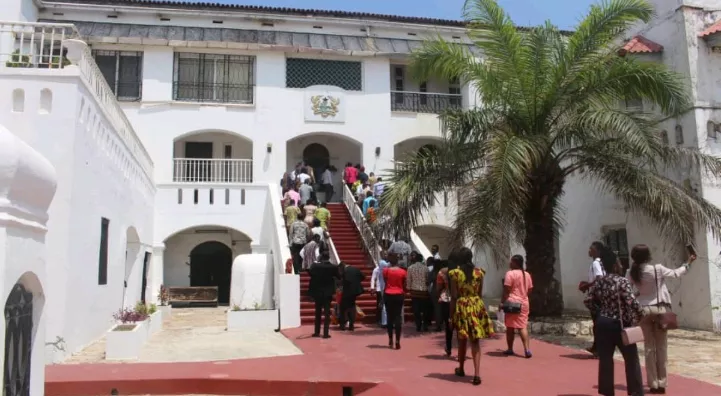A Visit to the King
Genre: Memoir
Format: Experience memoir
The sun was peeking out of its hiding place when we arrived at Osu Castle, although it is known as a Museum in Accra Ghana, we were introduced to a distinguished member of the incoming John Atta Mills administration. The member, a man of skillful intelligence and a deep well of knowledge gave us facts of this grandiose setting. We were prepared to be dazzled by its art and culture, and also to be equipped with vital information when we leave. The Osu Castle is located on the Gulf of Guinea in Africa. The castle’s origins can be traced to a lodge built by Swedes in 1652. Nine years later, the Danish built a fort on the site and called it Fort Christiansborg “Christian’s Fortress”, named after the King of Denmark, Christian IV. Over time, the fort was enlarged and converted into a castle.
With the permission of the staff of the castle assigned to us, I took a picture close to the water cistern in the courtyard inscribed with the name ‘’Carl Gustav Engmann’’, the Danish Governor of the fort from 1752 to 1757. Before the Danish arrived the Portuguese were there first. The Portuguese were the first to build a makeshift trading post on the site in the 16th Century. In 1661, the land was acquired by the Danes from the Ga King, Nii Okaikoi for 3200 gold florins. The Danes then built a small stone fort which they named after King Christian of Denmark and Norway. Thus the name “Christiansborg.”
As I stood on the battlement facing the Atlantic Ocean the tweet-tweet of the flamboyant air creatures resonated in the soul...
Format: Experience memoir
The sun was peeking out of its hiding place when we arrived at Osu Castle, although it is known as a Museum in Accra Ghana, we were introduced to a distinguished member of the incoming John Atta Mills administration. The member, a man of skillful intelligence and a deep well of knowledge gave us facts of this grandiose setting. We were prepared to be dazzled by its art and culture, and also to be equipped with vital information when we leave. The Osu Castle is located on the Gulf of Guinea in Africa. The castle’s origins can be traced to a lodge built by Swedes in 1652. Nine years later, the Danish built a fort on the site and called it Fort Christiansborg “Christian’s Fortress”, named after the King of Denmark, Christian IV. Over time, the fort was enlarged and converted into a castle.
With the permission of the staff of the castle assigned to us, I took a picture close to the water cistern in the courtyard inscribed with the name ‘’Carl Gustav Engmann’’, the Danish Governor of the fort from 1752 to 1757. Before the Danish arrived the Portuguese were there first. The Portuguese were the first to build a makeshift trading post on the site in the 16th Century. In 1661, the land was acquired by the Danes from the Ga King, Nii Okaikoi for 3200 gold florins. The Danes then built a small stone fort which they named after King Christian of Denmark and Norway. Thus the name “Christiansborg.”
As I stood on the battlement facing the Atlantic Ocean the tweet-tweet of the flamboyant air creatures resonated in the soul...



